The Definitive Guide to Web Push Notifications
Table of Contents
- Is this Guide for you?
- Introduction
- How do push notifications work?
- Stages for Push Notification
- Different types of Push Notification
- Web Push Notification Strategy
- Limitations of Push Notification
- 4 Sins of Web Push Notifications
- Spam your subscribers
- Clickbait
- Inconsistency
- All Fluff. No Stuff.
- Key Web Push Notification Statistics
- FAQS
Is this Guide for you?
Hello anonymous reader,
You have read about web push notifications or browser push notifications and aren't sure how to actually go about leveraging it as a marketing channel.
You are still unsure how does web push notification differ from app notifications or email. Or you are a pro-marketer who is currently debating about whether to double down on web push notifications and what should be the right strategy to do so.
You are a business owner or a marketer in an e-commerce company working on driving more sales using remarketing for cart abandoners. Or you are a media publisher, a SAAS company or a professional blogger currently trying to drive more traffic to your website & blog to get them into buyer journey.
Or you're simply looking for growth and marketing strategies and are looking for effective marketing channels.
This definitive guide of web push notifications is for you.
Note: In this ultimate guide we shall be using web push notifications and browser push notifications interchangeably.
Introduction
-
What are browser push notifications?
Browser Push Notifications are clickable notifications sent to a desktop or mobile device.
It is new marketing channel which allows you to reach out to your site visitors when these visitors are neither present on your website nor do you have their email or other such contact details.
These notifications can be sent only to visitors who have explicitly subscribed to receive web push notifications from your website. CTR of web push is estimated to be 4X-8X of email.
Currently Chrome, Firefox & Safari browsers support this web technology. Web Push Notification support is underway in IE and Opera.
Try Web Push Notification. Sign Up For Free
-
What are they used for?
Web Push notifications are an owned audience marketing channel that is primarily used for communicating time-sensitive information. They are also used for re-targeting, engagement & retention use-cases. Some of the common ones are outlined below:
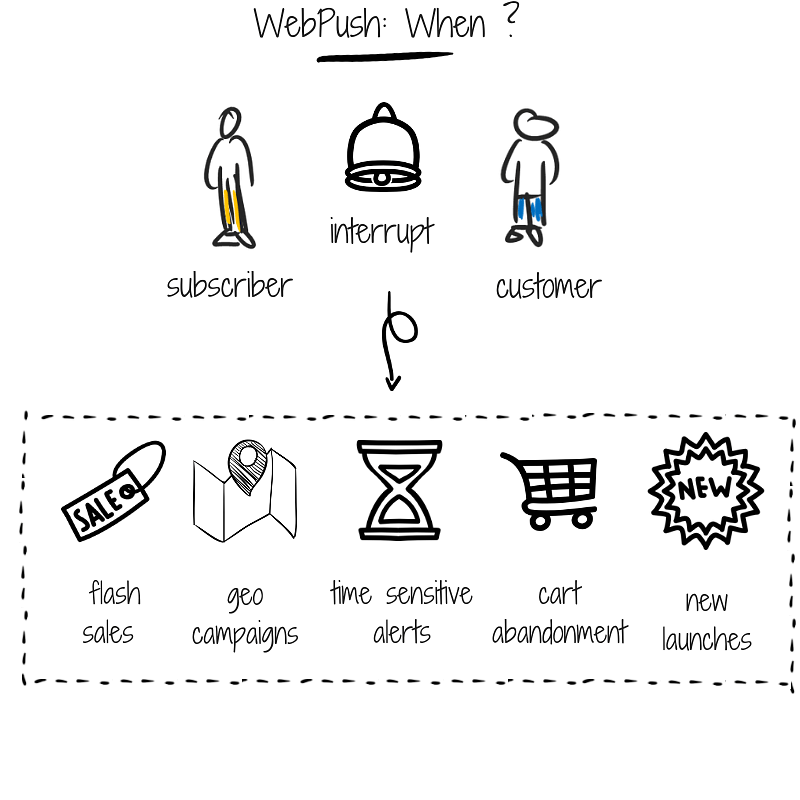
Alerts
1. Breaking News Alerts 2. Sale Event 3. Flight Notification 4. Sports Score Updates 5. Webinar UpdatesRe-targeting
1. Cart Abandonment 2. Product Page Abandonment 3. In-Stock UpdateEngagement
1. New Blog Update 2. Case Study UpdateRetention
1. Targeted discounts 2. Win-back campaigns -
What are the advantages of using Web Push Notification?
Web Push notifications offer significant advantages over other marketing channels like email, SMS, SEM, or PPC. The reason for it is:
-
High Opt-In
Opt-in process is significantly simpler than email. Since no personal information is required like email or phone number, hence you may get up to 10% opt-in rate.
-
Mobile App being unnecessary
Since browser push notifications work both on desktop & mobile devices hence you don't need to have the mobile app being present.
-
Increased engagement
Web push notifications are delivered even when the subscriber is not on your website nor is checking your email. This leads to significantly higher engagement.
-
High CTR
Web push notifications lead to interrupt in the work which the user is doing. Also, the delivery is instant and higher. Their CTR is estimated to be at least 4X-8X of email.
-
Better Delivery
Emails sometimes fail to deliver or hit spam (know reason why an email lands in SPAM). There are a lot of things going behind the scenes while delivering emails, and not every email is able to hit the Inbox all the time. In Gmail rather than coming to the inbox, they may be classified under promotions. However, browser push notifications face no such issues. Prompt & assured delivery is almost guaranteed.
-
Low Unsubscription Rate
Since it is a new marketing channel and unsubscribing from web push notifications is not straightforward for not tech-savvy audience hence the unsubscription rate is significantly low.
-
How do push notifications work?
You can break down web push notifications working process into three mini-steps;
- Subscription Permission
The first step in the entire process is asking the user's consent or permission to send him a notification. The user shall see either an opt-in box asking for permission. On clicking on allow, the push subscription is saved at the backend and later used to send web push notifications. - Sending Web Push Notification
The second step is composing the web push notification message and then sending it to the push subscription endpoint. At the endpoint, the message validation happens. There are a lot of technical details which I am skipping for simplicity. - Displaying Web Push Message
Once the user's browser is online, the notification is delivered from the push subscription endpoint. The browser decrypts the data and displays it on the user's browser.
To know more technical details about the entire process read the section below which goes into browser level specifics else you can skim it.
How do they work technically
Let's dive a bit deeper into the technicalities of push notification. Browser push notifications work on top of two API's:
-
Notifications API
used to configure and display notifications to the user -
Push API
used to subscribe your app to a push service and receive push messages in the service worker. Service worker, on the other hand, is like a background process running in your browser.
In order to make it happen the developer using web push notification needs to:
-
Service Worker Registration
Register the service on Chrome & Firefox. This is not required on Safari. -
Subscription ID
Subscribed ID is generated once the user allows receiving notifications from a specific website. This is used to route & deliver the message very similar to email or your mobile number -
Push Service
Each browser uses a Push Service like Chrome ( Firebase Cloud Messaging ), Firefox (Mozilla Pus Service ), Safari ( Apple Push Notification Service ).
Push Notification messages are sent from the server to Push Service using subscriber id. The message sent contains information about displaying the notification. When the client receives the message, the service worker ( background process ) wakes long enough to display the notification using the notification API.
-
Anatomy of Push Notifications
There are 7 different elements which constitute a browser push notification. Below is a breakdown of each element:
-
Title & Body Options
Two pieces of text that will be displayed on the notification. The title needs to grab the attention of your subscribers and the body should nudge them towards taking an action. -
Icon
Small image next to title & body. Super important for brand recall. Recommended size is 192px or more. -
Badge
The badge is a small monochrome icon that is used to portray a little more information to the user about where the notification is from. As of Sep 2018, it only works for Chrome on Android. -
Image
The image option can be used to display a larger image to the user. This is particularly useful to display a preview image to the user or to get his attention to say buy a product. -
Actions
Only Chrome & Opera on Android support actions. They are used for CTA's like getting the user to buy a product or go to a landing page or leave a YES /NO response. -
Direction
It determines the direction in which text will appear. Left-to-Right or Right-to-Left. Some languages like Arabic are Right to Left which is where this option is required. -
Vibrate
Vibrate option allows you to run a vibration pattern which will run when notification is displayed. This only affects devices that support vibration.
-
-
Which Browsers Support them
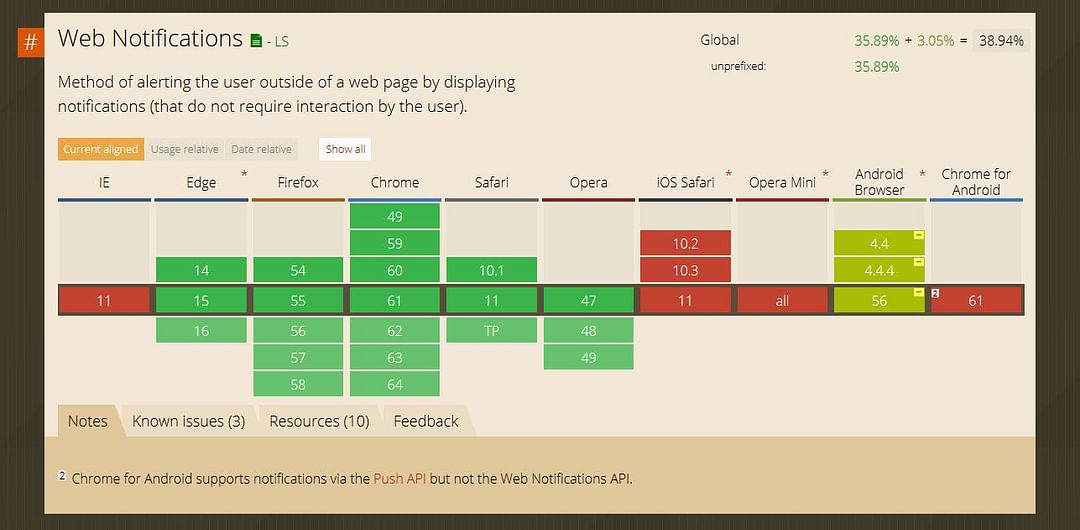
Currently, most desktop browsers support web push notifications. This includes Chrome, Safari, Firefox, IE Edge and Safari.
Support on mobile is comparatively limited with Chrome for Android, Firefox and Opera supporting web push notifications on mobile.
The major mobile browser missing in this list is iOS Safari. Future versions of mobile browsers including iOS Safari are very likely to have support for web push notifications.But what can you do for now? There is finally a workaround to reach out to your users on iOS. Facebook Messenger Push Notifications provide you with the luxury to reach out to users on iOS and engage with them (similar to the classic web push notifications).
Get started with Web Push for free
Stages for Push Notification
You can decide to build web push notification system for your app, however, I would advise you against it. Building this entire system, maintaining it, ensuring new browser updates are implemented, features like advanced segmentation, tagging, personalization and drip sequences exist etc. shall involve a lot of time of your development team.
A much better alternative is to use products like SendX which provides web push notification capability.
-
Adding to WebSite or Web-app
Adding SendX Web Push Notification script is straightforward. You just have to add a single line of javascript. Since it is served over Amazon CDN and is asynchronous hence it won't affect your page load time or speed.
Post that you have to enable web push from under Settings and you are set.
-
Browser Push Subscription Flow
When you are showing web push subscription prompt to your users is super important. You want to be sure that your users are already hooked or interested in your website.
You can set the position as well as time after which subscription prompt appears using Settings.
Also, you can decide what type of subscription prompt do you want to display - Native & Custom.
-
Native - Single step process
The Native prompt by default is a single step process. The prompt is shown by default by every browser and has only Allow or Deny options.
The other interesting thing is that Single step process can work only on HTTPS websites and not on HTTP.
The downside of using Native prompt is that a significant chunk of your user base may click Deny to the Native prompt. Post that you don't have any straightforward mechanism to enable it back.
-
Custom - Double step process
The custom prompt comes with a different set of strengths and weaknesses. Custom prompt provides you a much better opportunity to brand and position your product. You can use image and text describing what all interesting information you plan to send via browser notifications.
However, the real benefit of the custom prompt is that even when someone clicks Deny, you could still get him or her back on your website and try to get them to allow web push notifications second time around.
-
HTTP versus HTTPS
Like I said before, native - Single Step Process for web push needs HTTPS websites.
If you don't have HTTPS website then what?
Products like SendX create HTTPS subdomain on your behalf which can be used then by HTTP websites also for Native - Single Step Process.
The native subscription prompt works only on HTTPS websites and not on HTTP.
-
Pushing a notification
You can schedule a notification to go in future on say Sep 21, 2025, or right now.
You can also trigger them based on custom events or activities of a user.
In fact, you can have automatic web push notifications being sent from RSS feed either on daily, weekly or monthly basis.
Different types of Push Notification
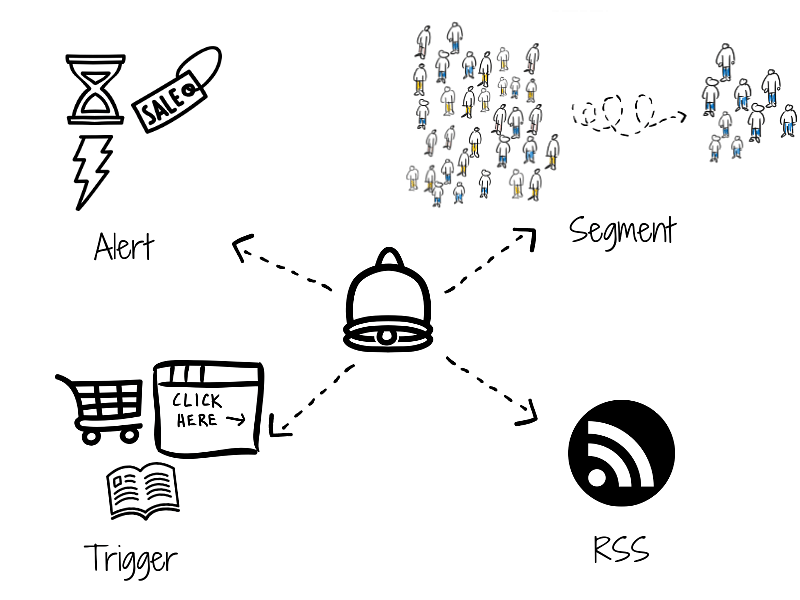
There are broadly 4 types of Push Notification:
1. Alert Based
They are generally used for flash sale, limited sale offer, exclusive offers etc.
2. Trigger Based
They are sent based on actions that a user performs on your website. This ranges from page visits to button clicks. Cart Abandonment, Shipping updates, Back in stock updates, Price Drop etc. fall in trigger-based notification category.
3. Segment Based
You can further create specific user groups based on geo, gender, location, custom activity or action. We can then target all our efforts in segment based web push notification.
4. RSS Based
You can link RSS feed to web push notification campaign. Automatically all-new stories will publish on its own without any manual intervention.
Web Push Notification Strategy
Web Push is an example of interrupt driven marketing.
A user is busy browsing a website and suddenly a notification comes which interrupts his or her workflow. Since it is a new marketing technology and there is no straightforward way to unsubscribe, the click rates on web push notifications are really high.
However, click rates shouldn't be misunderstood with conversion numbers. A lot of times users click on web push notifications by mistake. Also, frequent use of them leads you to dilute your brand and really annoy your users in return for a higher number of clickthroughs in short term.
That said, we push really outperforms other channels like email and SMS in certain scenarios. When used with caution and in tandem with email they can help you increase your revenue and ARPU ( annual revenue per user ) by a lot.
In industries like e-commerce, they are super effective in cart abandonment, flash sale, price drop & shipping update scenarios.
For media publishers, they work really well for breaking news, sports updates, stock market updates etc.
Likewise, they can be used very tactically by SAAS companies and professional bloggers for webinars, new product launches etc.
Let's quickly delve into metrics which we should be measuring for creating an iron-clad web push notification strategy.
-
Metrics to track:
-
Optin Rate
The number of unique visitors who have seen the web push subscription prompt and subscribed.
-
CTR Rate
The number of unique subscribers who received web push notification and clicked the notification so to know more.
-
Frequency & Timing
The number of web push notifications a web push subscriber is being sent, the number of clicks which are happening and at what time & week of the day.
This distribution shall help us understand at what saturation point sending more web push notification will lead to a drastic drop in subscriber engagement.
We shall also be able to understand whether web push notification works better on certain days, a certain time of the day for a specific segment of subscribers or not.
-
Conversion Rate
The number of web push subscribers who convert after clicking a notification. This is super crucial since most people don't measure conversions.
The conversion may be someone becoming a paying customer to someone downloading an ebook or signing up for a webinar.
It may quite happen that you are getting 10% CTR, however, your conversion numbers may be dismal.
Conversion rate shows the real effectiveness of our web push notification strategy.
-
-
Levers for effective Push Notification Strategy
-
Optin Prompt
Having the right opt-in prompt shall affect our visitor to subscriber number or opt-in rate. For web push notification you can decide to have a Native prompt ( Single Step Process ) or Custom prompt ( Double Step Process ).
As stated earlier, Native prompt shall lead to more opt-ins because friction for your end user is less. However, at the same time, a lot of users shall block it leading you to never get a chance to convert them into subscribers ever again. Also since Native Prompt doesn't allow any custom message hence your subscribers really don't know what they are signing up for leading to a high number of unsubscriptions later in the journey.
In the long run, we have seen the Custom Prompt to work far better than native prompt since it allows you to do expectation setting with your prospective subscribers and communicate to them the type of messages they shall be receiving. Also, you get multiple opportunities to get them to become a subscriber as they get to know more about your website or business.
-
Segmentation
If all you have is a hammer, everything looks like a nail - Maslow, Psychology of Science.
Being able to segment your subscribers based on pages they visit, geography, gender, custom actions they perform etc. will lead you to get a much better CTR.
You don't want to send a notification to a Manchester United fan about an Arsenal football match.
You don't want to talk in German to someone who understands only French.
-
Personalisation
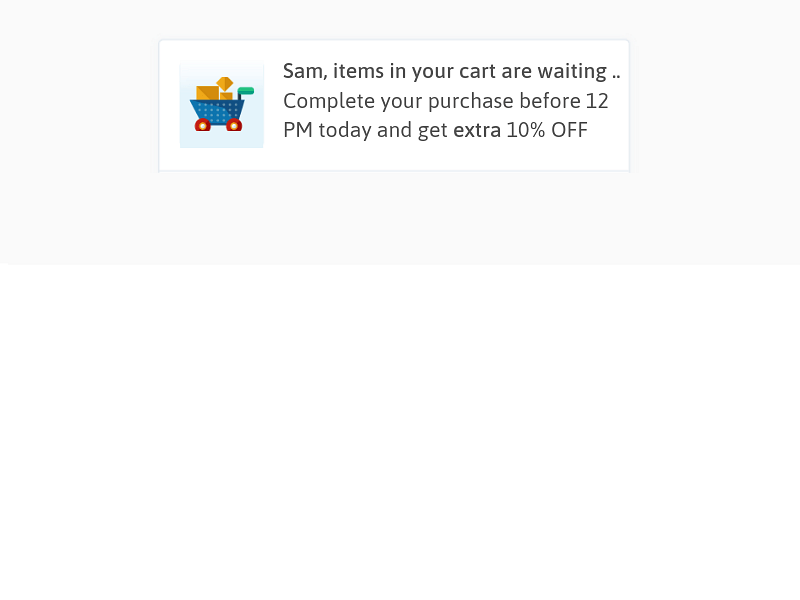
Being able to craft the message using personal attributes ( Name, Location ) or preferences ( choice, activity ) of your subscribers will ensure that your message finds resonance and strikes a note with your audience.
Personalisation, in tandem with segmentation, will be a major driver to get higher CTR rate.
-
CTA Buttons
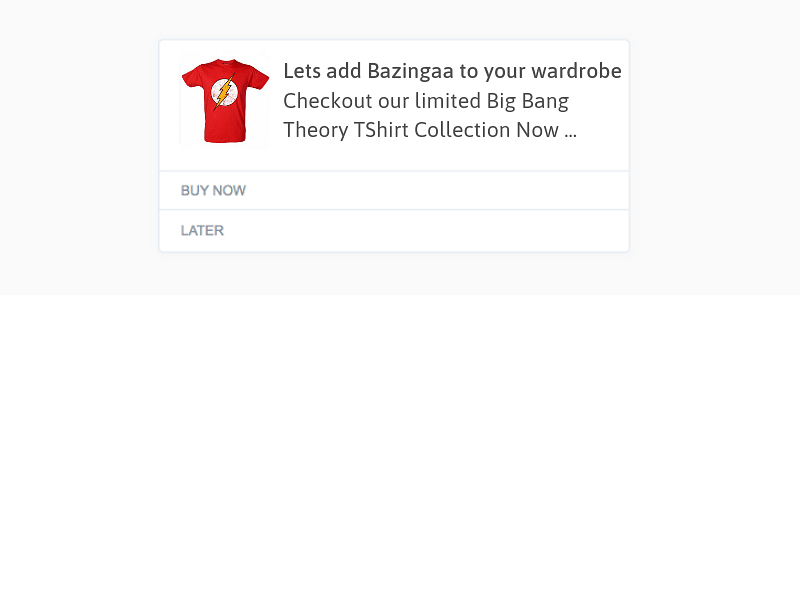
Despite having a well-crafted message to the right audience you may not get the desired results.
This is usually due to missing call to action. People are forgetful and they need to be told exactly what they should do.
So your web push notifications should have buttons to get them to download a book or book a webinar or buy the product.
The CTA needs to be explicit so that they don't even have to think before doing it.
-
Images
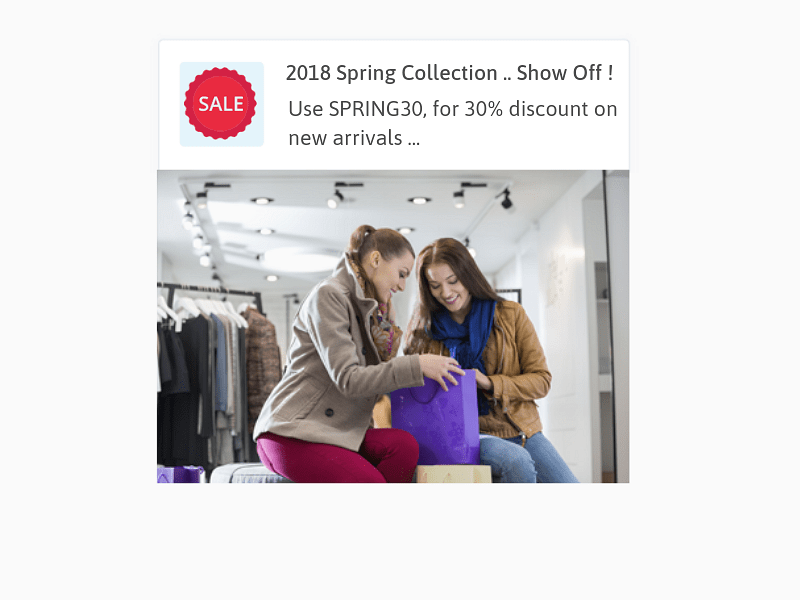
Web Push notifications have support for images across some browsers & platforms. Rich images pique interest.
Most of us don't read but scan. Just like you are doing right now while reading this blog.
In order to get your attention, I need to cause an interrupt which may be an unexpected flow of words or contrary information.
Since notification messages have a hard limit on the number of characters hence that interrupt can be caused by leveraging images.
-
A/B Testing
“If we have data, let’s look at data. If all we have are opinions, let’s go with mine.” – Jim Barksdale, former Netscape CEO
All marketers have strong opinions and a line of reasoning why the idea or strategy makes sense.
But almost always it is better to measure. To run different experiments and then double down on the ones which are working best.
So should you with your web push notifications.
Run A/B tests with different subject lines, emojis, images, CTA's, time of delivery, the day of delivery etc. and double down on the best performing versions.
-
Geo Optimised Send
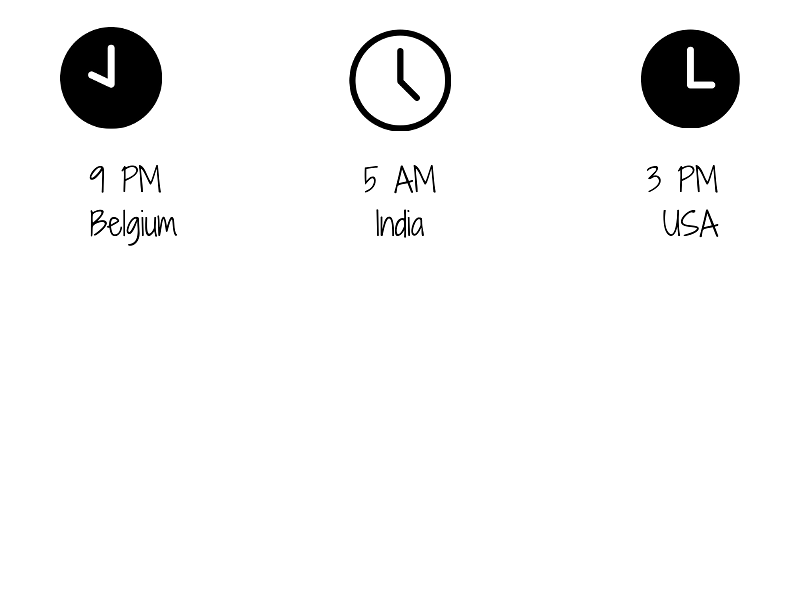
Your subscribers are in different countries and in different time zones. 9 AM in US timezone may be 11 PM in Australia timezone and 3 PM in Belgium.
It is almost impossible for you to send notifications at the right time based on your subscriber's country or timezone.
However intelligent web push notification software like SendX are able to do it and you should really leverage these features in your web push notification strategy.
-
Smart Send
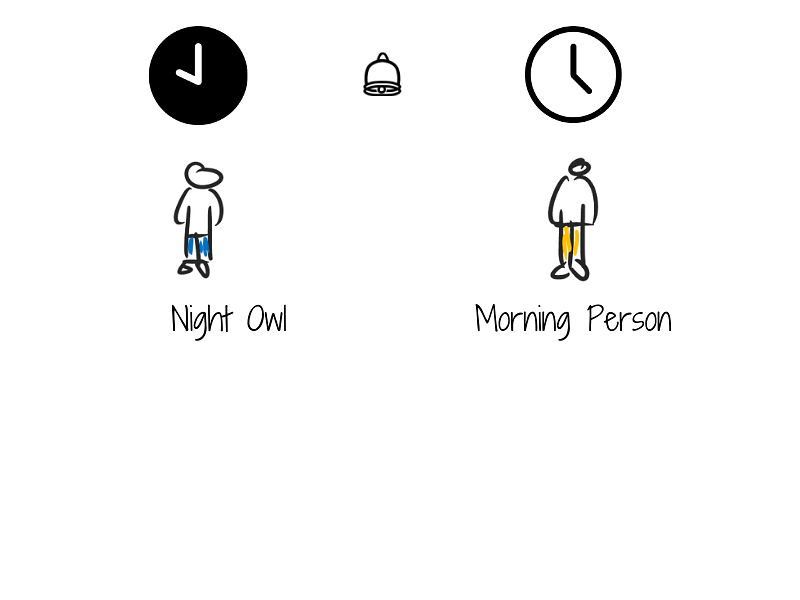
Your subscribers may be having different working hours. They may be more available or free during certain hours of the day.
Smart Send automatically sends the notification to optimize clicks from a subscriber based on historical information. This is another of those nifty features which can give your web push notification strategy a solid boost.
-
Limitations of Push Notification
So far I have tried to explain to you the inner workings of web push technology. Convince you of its merits. Helped you understand how it is being used across industries and how you can craft an effective web push notification strategy and leverage it for your business.
Now let me play devil's advocate and talk about the limitations of web push notifications and scenarios where it may not work.
We will first talk about technical limitations and how it affects the type of message communication you will be able to do with web push notifications.
-
Only HTTP Support
If you are running an HTTP website (say https://smallbiz.com ) you won't be able to run web push notifications natively. What this means is that you won't be able to have Native Single Step Optin. Nor will the web push notifications go from https://smallbiz.com.
However, you can still use web push notifications leveraging systems like SendX. A subdomain with HTTPS support shall be created on your behalf eg: https://smallbiz.sendx.io and your subscribers shall be subscribed to web push notifications to this subdomain. All the web push notifications shall also go from this domain.
-
No iOS Support
Web Push Notifications support on iOS is lagging. Hence if you have a reasonably large user base on iOS you will have to use other marketing channels.
-
Limited rich media support
Web Push Notification capabilities across various browsers and devices are not consistent. You can use big images and Call to Action Buttons only on a few browsers ( eg: Chrome ). Web Push Notifications generally are way behind app push notification eco-system in terms of maturity of rich media content.
-
Limited Text
Web Push Notifications message needs to be contained in a limited number of characters which again varies across browsers and operating systems. As a result, only certain content types are well suited for web push notifications primarily the ones which cause interrupt.
That said amongst the various marketing channels web push provides maximum ROI after email. The channel has yet not been saturated and hence you can get pretty amazing marketing ROI if you execute well.
4 Sins of Web Push Notifications
Now that you are familiar with the entire web push notification eco-system let me talk about some of the sins of web push notification which you as a marketer should never commit.
You may be tempted to commit them for short-term gains but trust me they are gonna be kill your brand & audience in the longer run.
-
Spam your subscribers
You have to hit your traffic and MQL numbers. I get it. But spamming your subscriber base by sending multiple web push notification is not the way to achieve it. The only thing you are doing is irritating the heck of your audience and diluting your brand.
Your immediate boss may look happy seeing the 10% CTR numbers. However, once the conversions numbers go low and brand equity dilutes you will be in serious trouble.
-
Clickbait
As a marketer, you are talking to humans. Web Push is providing you a direct access to your audience. Having clickability notifications will erase all the goodwill of your brand.
It may lead to some quick wins on traffic numbers but is just not worth in the longer run.
-
Inconsistency
You can't be sending web push notifications once a month nor 10 times a day. Better to set a rhythm which your audience can come to expect. Give them real value. Use web push strategically to get them complete a purchase ( cart abandonment etc. ), inform them ( via alerts ) or drive traffic to meatier and more valuable content for your audience.
-
All Fluff. No Stuff.
Sending high-level fluff message to everyone will appeal to no one. So get back to the drawing board and segment your audience. Craft unique messages for them based on demography, activity, intent, and stage in their buyer journey.
Key Web Push Notification Statistics
There are three kinds of lies: lies, damned lies, and statistics - Benjamin Disraeli
Some key statistics about web push notifications are:
- 7-10 % Opt-in rate from unique visitors to subscribers
- CTR rate of web push ranges between 4X to 8X of email across various industries.
- Average CTR of around 10.85% for notifications sent to less than 5000 subscribers. The CTR for email is around 3-4%
- Average CTR of around 4-6% for notifications sent to 25000+ subscribers.
- 10% unsubscription rate after allowing web push notification
- For Finance web push subscription has an opt-in rate of 15% and CTR of 30%. For gambling, the opt-in rate is 20% and CTR is 15%. For e-commerce opt-in and CTR hold steady at 10%.
- The adoption of web push notifications is highest for e-commerce followed by media publishers/blogs and SAAS companies.
The common objections range from causing irritation to users & spamming them to breaking site design and lack of consistent support across browsers.
If you were one of them before starting this guide, then I hope to have given you enough information, data and actionable tactical advise experimenting with web push notifications.
I hope that you will use your new found web push superpowers responsibly by not spamming your audience but giving them timely alerts and sharing valuable content.
May the force be with you :)
FAQS
- What are web push notifications?
Browser push notifications are clickable notifications sent to a desktop or mobile device. It allows you to engage your user even when they aren't present on your website.
- What are the advantages of using web push notifications?
Web Push notifications offer significant advantages over other marketing channels like email, SMS, SEM, or PPC. The reason for it is:
- High Opt-In
- Increased engagement
- High CTR
- Better Delivery
- Low Unsubscription Rate
- What are different types of web push notifications?
There are broadly 4 types of web push notifications:
- Alert Based: Generally used for flash sale, limited sale offer, exclusive offers etc.
- Trigger Based: Sent based on actions that a user performs on your website. Cart Abandonment, Shipping updates, Back in stock updates, Price Drop etc. fall in trigger-based notification category.
- Segment Based: You can further create specific user groups based on geo, gender, location, custom activity or action and then send segment based web push notification.
- RSS Based: You can link RSS feed to a web push notification campaign. Automatically all-new stories will publish on its own without any manual intervention.
- How are web push notifications different from push notifications sent via apps?
While both are technically identical, the biggest difference is that web push notifications are used for desktop while app push notifications are sent to mobile devices.
- Can I use SendX to send web push notifications?
Absolutely. Let's assume you are running an HTTP website (say https://smallbiz.com ) you use SendX to create a subdomain. A HTTPS support shall be created on your behalf eg: https://smallbiz.sendx.io and your subscribers shall be subscribed to web push notifications to this subdomain. All the web push notifications shall also go from this domain.


